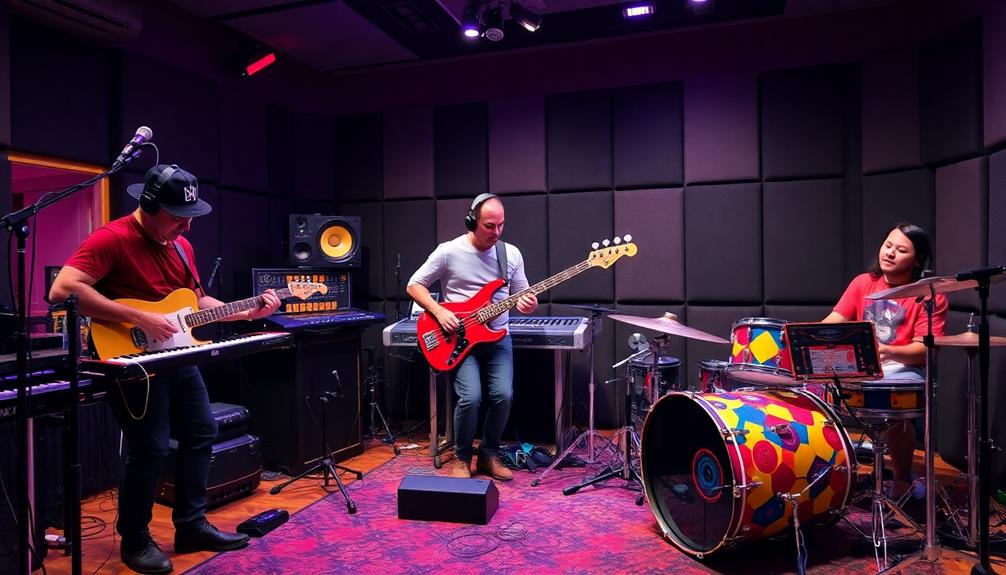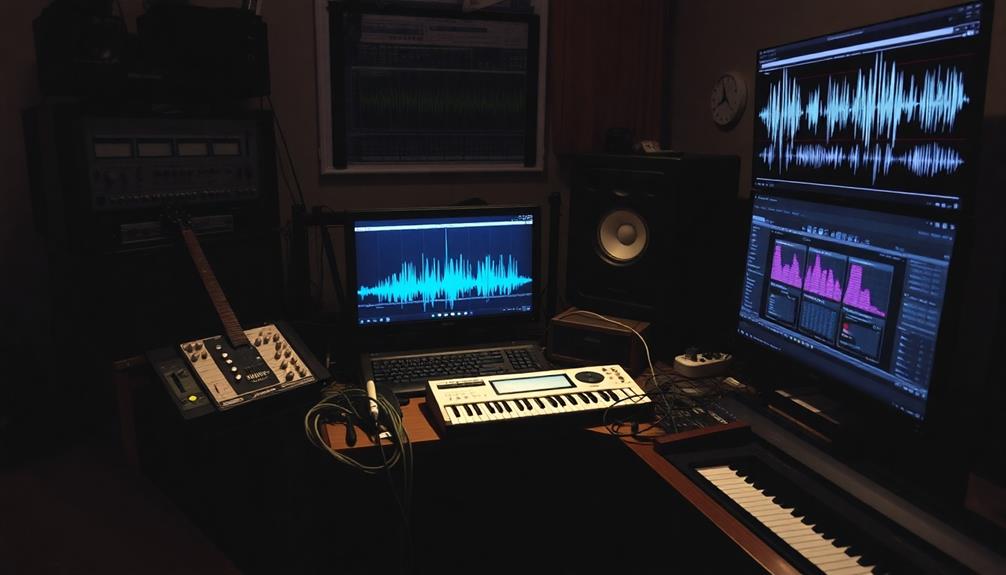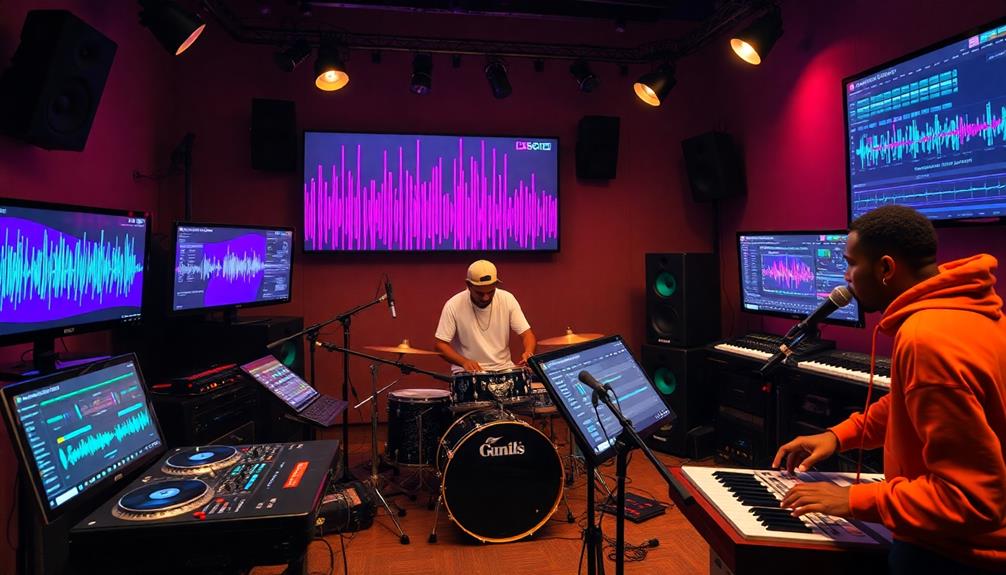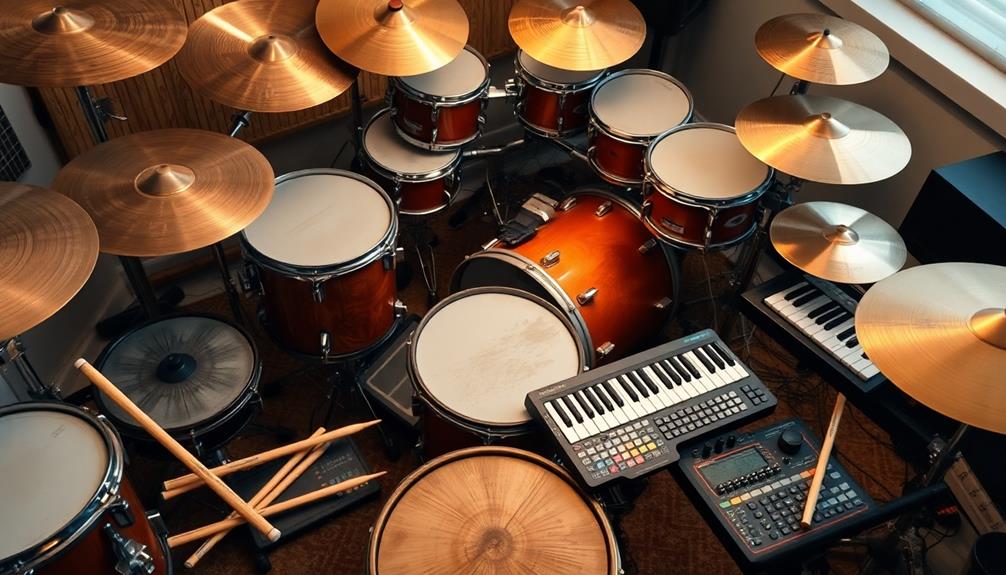Layering instruments effectively transforms your music, creating a fuller sound that captivates listeners. Start by selecting contrasting elements, like bass and synths, to enhance depth and texture. Use EQ and panning to carve out space for each layer, preventing frequency clashes. Techniques like multi-octave layering and dynamic variations bring richness to your sound. Prioritize a strong primary layer while carefully arranging complementary sounds. Don't overlook the use of modulation for added movement and unique textures. Exploring these techniques can elevate your compositions greatly—there's so much more you can achieve with simple tweaks to your approach!
Key Takeaways
- Layering different sound elements enhances depth and richness, creating a more engaging audio experience.
- Utilize EQ and panning to avoid frequency clashes, ensuring clarity in the mix.
- Employ multi-octave layering and detuning to widen the sonic spectrum and add richness.
- Layering vocals and percussion with dynamic variation enhances emotional depth and impact.
- Regularly assess frequency content and prioritize a primary layer for cohesive sound.
Understanding Layering Techniques

When it comes to creating a fuller sound in your music, understanding layering techniques is key. Layering sounds involves combining different elements like synths, vocals, and percussion to enrich your audio experience. To achieve effective layering, you'll want to focus on contrasting sound characteristics. For example, blending a detuned synth with a clean lead can enhance the mix's width and depth, making your track more engaging.
Consider using multi-octave layering, where you stack sounds across various octaves. This approach adds a massive sound experience and introduces richness and dimension to your composition.
Additionally, employing EQ and panning strategies is crucial. This helps avoid frequency clashes and guarantees each layer occupies its own space in the stereo field, leading to a clearer mix.
Don't overlook techniques like attack layering and sustained layering. Short, punchy layers contribute impact, while slower, evolving layers can add depth, enhancing the dynamic quality of your sounds.
Benefits of Layering Instruments

When you layer instruments, you instantly enhance the sound depth of your track, making it feel richer and more engaging.
This technique not only fills out frequency gaps but also adds a unique sonic character that sets your music apart.
Enhanced Sound Depth
Layering instruments can transform your music by adding depth and richness that single sounds simply can't achieve on their own. When you layer sounds, you combine various textures and timbres, resulting in an audio experience that's fuller and more immersive.
By employing contrasting characteristics—like blending acoustic and synthetic instruments—you create a dynamic and engaging sonic landscape. Techniques such as detuning and multi-octave layering help you widen the sonic spectrum, contributing to the enhanced sound depth of your mix.
This approach fills frequency gaps that individual instruments might leave, ensuring a cohesive and balanced overall sound.
Moreover, incorporating ambient sounds and unique recordings alongside your primary instruments adds another layer of interest and complexity, enriching the listening experience.
You'll find that the depth you achieve not only makes your music more enchanting but also invites listeners to explore every nuance of your composition.
Unique Sonic Character
Creating a unique sonic character is one of the standout benefits of layering instruments in your music. When you layer different sounds, you introduce distinct characteristics that enrich your overall sonic palette, making your tracks more engaging and dynamic. By combining contrasting timbres—like blending acoustic guitars with electronic synths—you create a unique texture that stands out in today's crowded musical landscape.
To achieve unique sonic identities, focus on the careful selection of layers. Each sound should contribute its qualities, ensuring your mix doesn't conform to common trends. This approach allows you to integrate various frequency ranges, filling gaps and achieving a more balanced and fuller sound.
Don't forget these layering tips: experiment with different instruments and effects to enhance emotional depth. This layering process can help you convey various feelings and atmospheres, resonating with listeners on multiple levels.
Ultimately, crafting a unique sonic character through layering not only differentiates your music but also invites your audience to connect more deeply with your creative vision. So, immerse yourself in the world of layering and discover the rich textures waiting to be revealed in your sound!
Selecting Sounds to Layer

To achieve a rich and dynamic sound, selecting the right layers is essential. When you layer multiple sounds, make sure each serves a distinct purpose and contributes unique characteristics. This approach prevents muddiness in your mix. Aim to incorporate contrasting sound qualities; for example, pairing bright synths with warm acoustic instruments can greatly enhance depth and richness.
Prioritize a primary layer that dominates the mix while ensuring that additional layers complement and enhance its tonal qualities without overpowering it. This balance is critical for maintaining clarity in your sound.
Also, consider utilizing different sound sources, like combining analog synths with sampled acoustic instruments, to create a more organic and textured sound.
Regularly assess the frequency content of your layered sounds using EQ. This step is essential for carving out space and preventing frequency clashes, which can muddy your overall mix.
Effective Layering Methods

Achieving a fuller sound involves employing several effective layering methods. First, focus on frequency separation by using EQ to carve out distinct ranges for each layer. This guarantees they complement each other in the mix, filling the frequency spectrum without clashing.
Furthermore, just as AI customizes learning experiences in e-learning, you can customize your sound layers to fit the unique needs of your track. Next, consider detuning your oscillators slightly, around ±10 cents. This technique widens the sound and adds richness when layering synths.
Octave layering is another powerful method. Pair low bass layers with higher melodic elements to enhance fullness and create a dynamic sound landscape.
Don't forget about panning and spatial distribution; pan your layered instruments away from the center to craft a more expansive stereo image. This helps each sound be distinctly heard without cluttering the mix.
Lastly, introduce dynamic variation in velocity and articulation across your layers. This is particularly effective in percussive elements, adding depth and an organic feel to your music.
Layering for Vocal Richness

Layering vocals transforms your mix into a rich tapestry of sound that captivates listeners. By recording multiple takes of the same line and panning them across the stereo field, you create a "wall of sound" effect that adds depth and richness to your mix.
Here are some techniques to enhance your vocal recordings:
- Utilize natural doubling techniques to capture harmonies and ad-libs.
- Experiment with varying dynamics and textures, like breathy whispers alongside powerful belting.
- Incorporate vocal effects such as reverb and delay for seamless blending.
- Use harmonized vowel sounds like "Ooo" or "Ahh" for warmth and fullness.
- Pay attention to the arrangement, ensuring layers complement each other.
These strategies not only enhance the emotional impact of choruses but also create a more engaging auditory experience.
With careful attention to detail, you'll find that layering vocals elevates your music, making it feel more organic and inviting.
Enhancing Percussion With Layers

After enriching your vocal layers, it's time to turn your attention to percussion. Start by layering different snare samples; using a top snare for that crisp crack and a bottom snare for added body creates a punchier sound. This combination enhances the overall impact of your percussion section, making it feel fuller.
Next, consider your kick drum. Pairing it with a sub-bass layer considerably deepens the low-end frequencies, establishing a more powerful rhythm foundation. This combo gives your track the weight it needs to drive the energy forward.
To keep things interesting, vary the velocity and dynamics of your layered percussion elements like hi-hats or shakers. This approach introduces an organic feel, adding depth to your rhythm.
Additionally, don't shy away from incorporating ambient sounds, such as field recordings or subtle sound effects. These elements enrich your percussion layers, offering unique character to your mix.
Using Modulation for Depth

While you're refining your layered sounds, adding modulation can greatly enhance their depth and presence. By introducing subtle changes in pitch, amplitude, or filter settings over time, modulation creates a dynamic listening experience that keeps your audience engaged.
Here are some key benefits to reflect on:
- Introduces movement and life to static layers
- Prevents phase cancellation, maintaining clarity
- Allows for unique textures with varying modulation rates and depths
- Enhances cohesion among multiple layers
- Adds an element of surprise to your mix
Utilizing modulation plugins, like LFOs (Low-Frequency Oscillators), lets you automate adjustments to parameters such as volume or pan. This adds movement and depth, making your layered sounds feel more expansive.
Experimenting with different modulation settings can yield engaging textures, turning your mix into a complex tapestry of sound.
Incorporating modulation into your mixing process not only enriches the individual layers but also enhances the overall cohesiveness of your track.
Group Processing Strategies

Group processing strategies play an essential role in enhancing the cohesion and clarity of your mix. By routing multiple layers of instruments to a single bus, you can apply effects like compression, which unifies the sounds. For ideal results, use slow to medium attack and release settings during group compression; this typically yields a natural, cohesive sound across your layered instruments.
Here's a quick reference table for effective group processing strategies:
| Strategy | Description | Benefits |
|---|---|---|
| Group Compression | Send layers to a bus with careful gain reduction | Enhances clarity and cohesion |
| Multiband Compression | Control specific frequency ranges | Fine-tunes without losing integrity |
| Group Saturation | Introduces harmonics and warmth | Enriches sound and adds character |
Aim for a gain reduction of 1-3 dB to maintain subtlety while polishing your mix. Finally, don't underestimate the power of group saturation techniques; they can greatly enhance the overall warmth and richness of your layered instruments, making your sounds more engaging.
Common Layering Mistakes

When layering instruments, many musicians fall into common traps that can compromise their mix. Recognizing these pitfalls can help you create a more engaging sound.
Here are some mistakes to watch out for:
- Overloading your mix with too many layers
- Layering identical tonal qualities without variation
- Failing to utilize proper EQ techniques
- Neglecting to arrange layers according to song structure
- Ignoring dynamic variation in your layers
Real-World Layering Examples

Layering instruments effectively can greatly enhance your sound, bringing depth and richness to your music. For instance, try combining a bass guitar with a synth bass. The bass guitar adds warmth and presence, while the synth delivers punch and clarity, creating a robust low-end foundation. Additionally, utilizing loop integration techniques can further enhance your layering process, allowing for enchanting compositions.
You can also layer strings with a synth pad. The strings provide organic warmth, and the pad enhances depth and texture, resulting in a rich, atmospheric sound.
In the domain of percussion, consider layering a kick drum with a sub-bass. This combination enhances low-end impact, where the kick gives rhythmic attack, and the sub-bass adds depth and fullness.
When it comes to guitars, layer a clean guitar with a distorted one. This setup creates a fuller, more dynamic sound, with clarity from the clean guitar and grit from the distorted track.
Finally, layering woodwinds, like flutes and clarinets, produces a lush harmonic texture. The flute brings brightness, while the clarinet adds warmth, enhancing the overall orchestral sound.
Frequently Asked Questions
How Do You Make an Instrument Sound Fuller?
To make an instrument sound fuller, you can use techniques like layering sounds, adding effects, and experimenting with different octaves. These methods enhance richness and depth, creating a more engaging auditory experience for your listeners.
What 4 Instruments Sound Good Together?
You'll find that a grand piano, acoustic guitar, strings, and synth pad blend beautifully, creating a rich sound. Alternatively, a bass guitar, electric guitar, flute, and clarinet also complement each other well, adding depth.
How to Layer Sounds Properly?
To weave a beautiful tapestry of sound, you'll want to start with a strong foundation, choose contrasting textures, carve out space with EQ, and pan creatively to create an inviting, immersive listening experience.
What Is the Layering of Musical Sounds Called?
The layering of musical sounds is commonly known as sound layering. You combine different audio sources, enhancing depth and richness in your mix. This technique helps create a more engaging and textured listening experience.
Conclusion
Layering instruments can seem complex, but it's really about creativity and exploration. Don't worry if you think you lack the skills; even simple layers can transform your sound dramatically. By experimenting with different combinations, you'll discover a richer, fuller texture that enhances your music. So, immerse yourself and start layering—your tracks will thank you! Remember, every great musician started somewhere, and your unique sound is just waiting to be uncovered.










